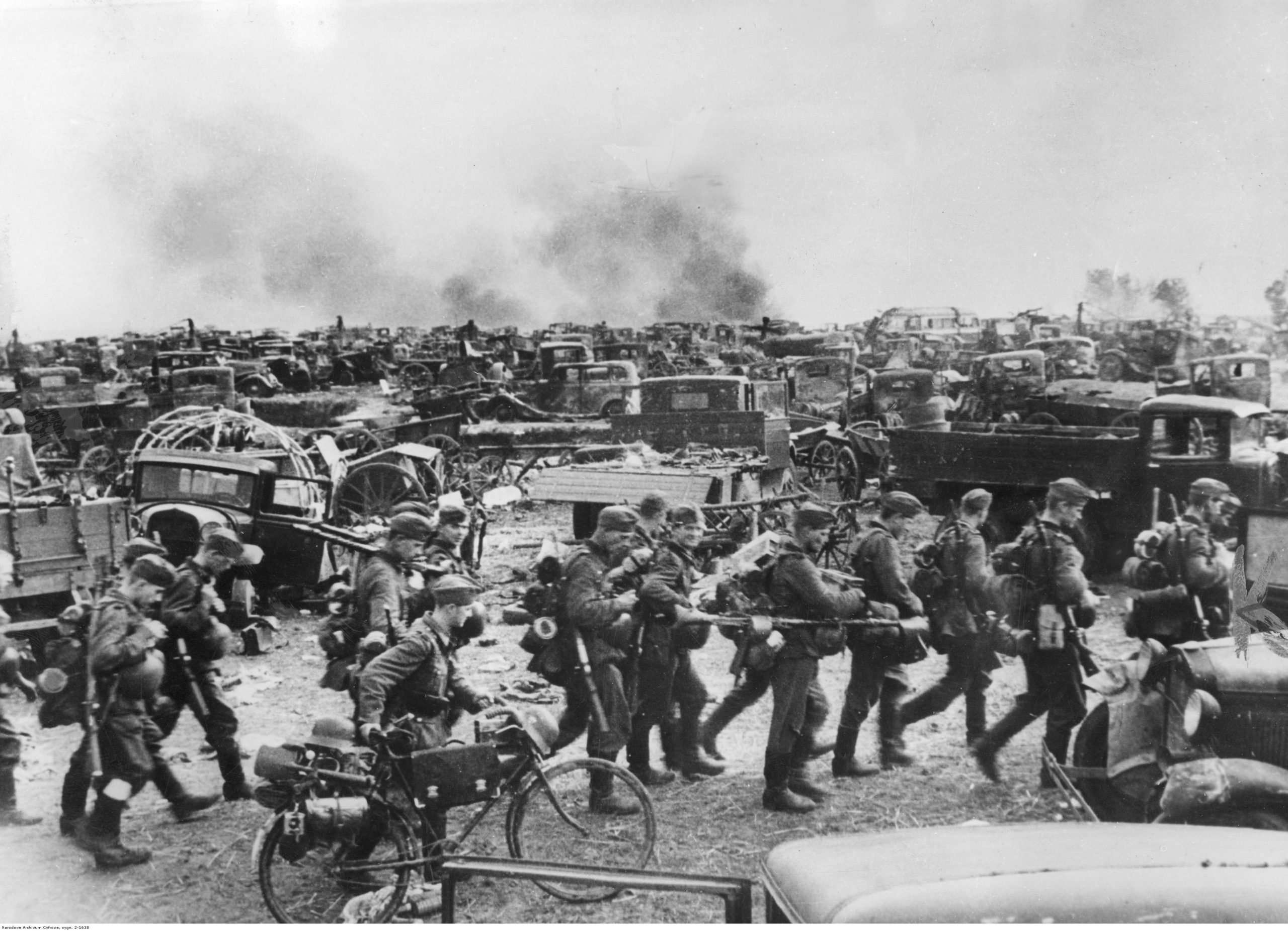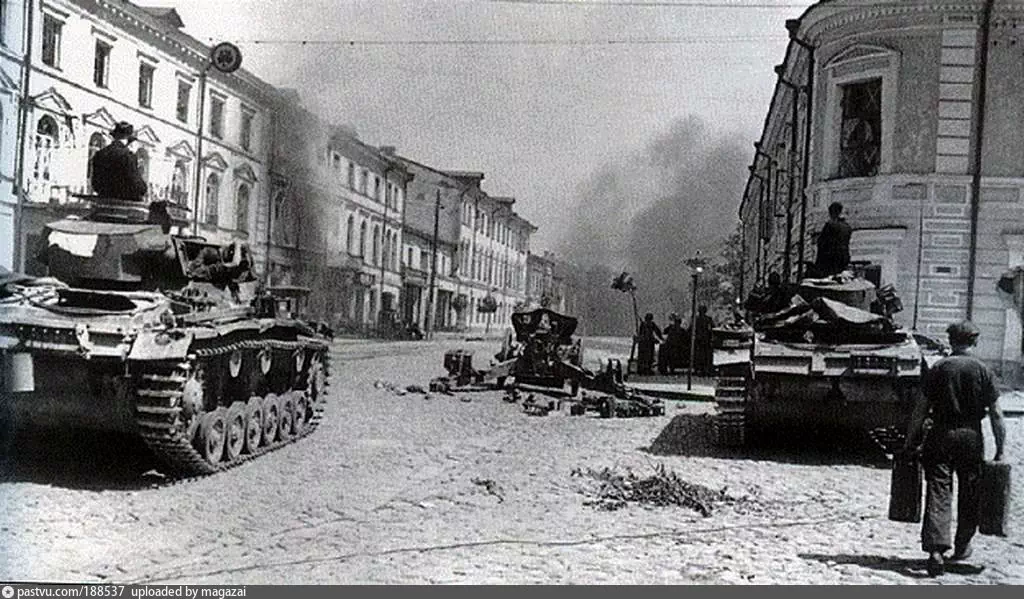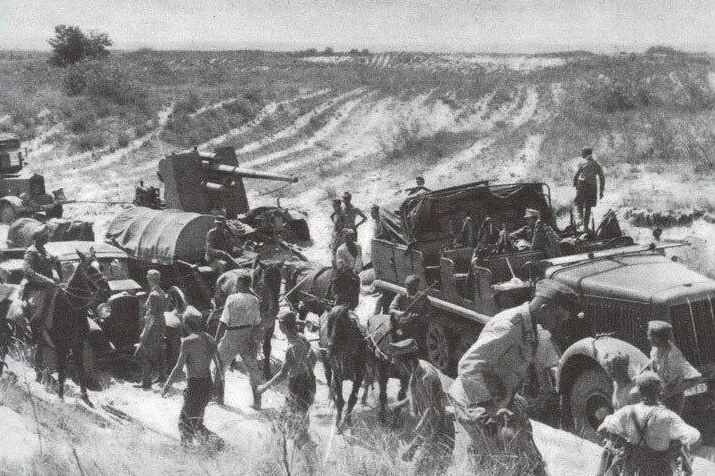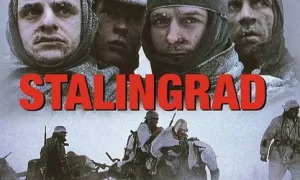Battle of Kiev, Kiev operation (1941), Kiev cauldron – a large-scale battle of the Great Patriotic War between the USSR and Germany in July – September 1941, ending with the encirclement and defeat of the Red Army.
Plans of the German command in July
By mid-July 1941, the German command (OKW) made a strategic decision on the further development of the operation to seize the territory of the USSR. In OKW Directive No. 33 of July 19, Hitler ordered the main objectives of the offensive to be changed in such a way that even before the onset of winter, occupy Donbass and Crimea in the south, and Leningrad in the north, joining with the Finns. Directive No. 33 read:
1…. Active operations and freedom of maneuver of the northern flank of Army Group South are constrained by the fortifications of Kiev and the actions in our rear of the troops of the 5th Soviet Army.
- The goal of further operations should be to prevent the withdrawal of large enemy units deep into their territory and to destroy them. To do this, prepare in the following areas:
- a) The southeastern section of the Eastern Front. The most important task is to destroy the 12th and 6th armies of the enemy with a concentric offensive west of the Dnieper, preventing them from retreating across the river.
On July 30, OKW Directive No. 34 was issued, which effectively canceled Directive No. 33 and its supplement. Directive No. 34, in particular, ordered Army Group Center to go on the defensive, and Army Group South to continue operations in order to destroy large forces of Soviet troops west of the Dnieper and, by seizing bridgeheads on the Dnieper, create conditions for a subsequent crossing 1 th tank group on the eastern bank of the Dnieper.
Operations as part of the strategic defensive operation of the Red Army
The operation was carried out by the troops of the Southwestern Front and part of the forces of the Pinsk military flotilla. During the hostilities, the 21st Army of the Central Front, the 6th and 12th Armies of the Southern Front, the 37th, 38th and 40th Armies, newly created as part of the Southwestern Front, were additionally introduced. A total of 28 divisions and 4 brigades. As part of this operation, the Korosten front-line defensive operation, the defensive operation on the outskirts of Kiev, the Uman and Kiev-Priluki front-line defensive operations were carried out.
Duration – within 82 days. The width of the combat front is 300 km. The depth of withdrawal of Soviet troops is 600 km.
The course of hostilities in July
 Given the complexity of the situation, on June 30, the Headquarters of the Supreme High Command ordered the commander of the Southwestern Front to withdraw troops to the line of fortified areas along the former state border of 1939, and, relying on them, organize a solid defense. Fulfilling the order, the 5th Army retreated to the Korosten UR, and the 6th Army – to the Berdichev region and to the south, having the task of taking up defense in the Novograd-Volynsky fortified area.
Given the complexity of the situation, on June 30, the Headquarters of the Supreme High Command ordered the commander of the Southwestern Front to withdraw troops to the line of fortified areas along the former state border of 1939, and, relying on them, organize a solid defense. Fulfilling the order, the 5th Army retreated to the Korosten UR, and the 6th Army – to the Berdichev region and to the south, having the task of taking up defense in the Novograd-Volynsky fortified area.
At this time, units of the 3rd Motorized Corps (Ebergard von Mackensen) from the 1st Panzer Group of Colonel-General von Kleist managed to break through the 60-km gap between these armies.
On July 9, the enemy occupied the city of Zhitomir and rapidly developed an offensive along the Zhitomir highway towards Kiev with the forces of two tank divisions. On July 11, tank reconnaissance of the German 13th Panzer Division came into combat contact with the Kiev fortified area on the Irpin River.
Being in a dangerous situation, the 5th army of General M. I. Potapov, with the forces of the shock group (31 sk, 9, 19 and 22 microns), launched a counterattack on the formations of the 6th army and the 1st tank group of the Germans in the area of the city of Novograd -Volynsky. This forced the command of Army Group South to turn nine divisions north. Thus, the active actions of the troops of the 8th and 15th, 9th and 19th mechanized corps operating in the Dubno-Lutsk region, and, first of all, the field units of the 5th and 6th armies of the South-Western Front, during the period of July 9-14, fettered the main forces of the army group “South”, aimed at the Kiev direction. They played a decisive role in repelling the first German attempt to capture the capital of Ukraine.
After repulsing Soviet attacks, the 3rd Motorized Corps was drawn into positional battles for two weeks near Kiev, waiting for the approach of the lagging infantry of the 6th Army. At the same time, the 48th Motorized Corps of the 1st Panzer Group continued to advance in a southeasterly direction. The 14th motorized corps advanced into the gap between the 3rd and 48th motorized corps. In fact, after the breakthrough of the “Stalin Line”, the German mobile formations dispersed like a fan, having lost to some extent operational communication with each other.
In the 20th of July, the 5th Soviet Army (M. I. Potapov) fought with the 6A infantry divisions near Korosten and Malin. The 26th army (F. Ya. Kostenko) at that time was conducting a counteroffensive against the 14th motorized corps of the Germans, with the task of capturing the city of Fastov.
In mid-July, the German 17A began an active offensive in the direction of Vinnitsa. The Soviet 12th Army under the command of P. G. Ponedelin was forced to leave the city. In addition, a wide gap in the front was formed between the 26th and 6th armies in the area of the city of Belaya Tserkov. These factors forced the Soviet command to withdraw the 6th and 12th armies to the Uman region. But by the end of the month, the German tank units were able to catch up with the retreating ones and, together with the infantry of the German 17th Army, form the Uman pocket.
On July 30, the enemy delivered a strong blow with the forces of three infantry divisions to the 64th sk of the 26th army at the junction of the 165th and 175th sd on the narrow front of Pinchuk – Vinnitsa Stavy. It was here, along the Bila Tserkva-Kyiv highway, that the enemy sought to break into the city of Kyiv from the south.
The scattered units of the 165th Rifle Division were pushed back to the northeast by the morning of July 31st. The 175th Rifle Division and the combined detachment of Major General F.N. Matykin (tank, motorized rifle battalions, artillery regiment) withdrew to the southern sector of KiUR, and the 165th Rifle Division – beyond the Dnieper, occupying the area from the village of Bortnichi to Voronkov.
The course of hostilities in early August
 The battle for Kyiv took on an even more fierce character – the Germans could not develop an offensive while the Dnieper line was covered by a strong group of Soviet troops. In the Kyiv area, the Germans were held back by the organized resistance of several Soviet armies.
The battle for Kyiv took on an even more fierce character – the Germans could not develop an offensive while the Dnieper line was covered by a strong group of Soviet troops. In the Kyiv area, the Germans were held back by the organized resistance of several Soviet armies.
The townspeople took an active part in the defense of Kyiv. Since the beginning of the war, more than 200,000 Kyivans (including 16,000 communists and 40,000 Komsomol members) have voluntarily joined the Red Army. Formed a people’s militia. Every day, more than 160 thousand citizens built defensive lines – they built 3 lines of defense, dug a 25-km anti-tank ditch, and built about 700 bunkers.
Until August 11, the Nazis, with the support of large artillery and aviation forces, continuously attacked the defensive orders of the Kyiv fortified area and the 27th Rifle Corps.
Reflection of the assault on KiUR. On the night of August 7, the 5th airborne brigade of Colonel A. I. Rodimtsev was transferred to the direction of the main attack of the German troops advancing on Kyiv. The counterattack carried out by the brigade made it possible to stabilize the situation for some time. But all these were only half measures. The paratroopers did not have combat experience and heavy weapons, and they could only oppose the German infantry with high morale. The Soviet command managed to avoid the catastrophic development of the situation near Kiev only by bringing freshly formed divisions into battle. The 284th Rifle Division of Colonel G.P. Pankov and the 295th Rifle Division were transferred to the troops of the 37th ArmyColonel I. D. Andryukov. Already in the evening of August 8, on the day of the entry into battle of the brigade of A. I. Rodimtsev, two echelons of the 284th Infantry Division were unloaded. The arrival of the 284th division made it possible on August 11 to carry out a productive counterattack in the Mousetrap area. On August 12-14, Tarasovka, Novoselki, Chabany and Pirogovo were liberated. At the same time, pillboxes of KiUR were released, which for almost a week fought in an environment. By August 16, the situation was completely restored, and the situation near Kiev stabilized.
– Isaev A.V. Boilers of the 41st. The history of the Second World War, which we did not know.
Position as of mid-August
June – August 1941
By mid-August 1941, the forces of the German Army Group South reached the Dnieper along the entire course from Kherson to Kiev. Army Group Center, advancing north of the Pripyat swamps, advanced to Smolensk.
The advanced units of the 1st Panzer Army crossed the Dnieper at Zaporozhye. After stubborn fighting, a pontoon crossing in Dnepropetrovsk was also captured. At the same time, the 17th Wehrmacht Army managed to cross the Dnieper at Kremenchug and create a bridgehead on the left bank of the river to Cherkassy. The 6th Army came close to Kiev.
On the same day, the 5th Army of Major General of Tank Troops M. I. Potapov, who covered Kiev from the north in the Chernobyl-Ivankov region, received an order to withdraw beyond the Dnieper. Thus, the forces of the Soviet Southwestern Front, located in the bend of the Dnieper, were threatened with encirclement. Five Soviet armies were concentrated here (from north to south): 21st (commander – Lieutenant General V.I. Kuznetsov ), 5th (commander – Major General M.I. Potapov ), 37th (commander – Major General A. A. Vlasov ), 26th(commander – Lieutenant General F. Ya. Kostenko ), 38th (commander – Lieutenant General D. I. Ryabyshev ).
Plans of the parties in August
Germany
 On August 18, the Chief of the General Staff of the German Ground Forces, Franz Halder, presented to Adolf Hitler a plan to strike at Moscow with the forces of Army Group Center. However, on August 20, Hitler bluntly rejected this proposal and on August 21 signed a directive according to which part of the forces of Army Group Center should turn south in order to encircle and destroy the South – Western front of the Soviet troops. The directive determined that “the most important task before the onset of winter is not the capture of Moscow, but the capture of the Crimea, industrial and coal areas on the riverDonets and the blocking of the Russian oil supply routes from the Caucasus”.
On August 18, the Chief of the General Staff of the German Ground Forces, Franz Halder, presented to Adolf Hitler a plan to strike at Moscow with the forces of Army Group Center. However, on August 20, Hitler bluntly rejected this proposal and on August 21 signed a directive according to which part of the forces of Army Group Center should turn south in order to encircle and destroy the South – Western front of the Soviet troops. The directive determined that “the most important task before the onset of winter is not the capture of Moscow, but the capture of the Crimea, industrial and coal areas on the riverDonets and the blocking of the Russian oil supply routes from the Caucasus”.
On 23 August, Halder personally delivered this directive to the headquarters of Army Group Centre, where it was met with disapproval, especially by the commander of the 2nd Panzer Group, Heinz Guderian. On the same day, Guderian flew to Hitler’s headquarters, where he unsuccessfully tried to convince the Fuhrer of the need to attack Moscow.
Here is how Guderian himself described this conversation with Hitler:
I tried to explain to Hitler that after achieving military success in a decisive direction and defeating the main enemy forces, it would be much easier to capture the economically important regions of the Ukraine, since the capture of Moscow – a junction of the most important roads – would make it extremely difficult for the Russians to transfer their troops from north to south.
I recalled that the troops of Army Group Center were already in full combat readiness for an attack on Moscow, while the proposed attack on Kiev was due to the need to transfer troops to the southwest, which would take a long time; moreover, in the future, when attacking Moscow, the tank troops will have to cover the same distance again, that is, from Roslavl to Lokhvitsa, equal to 450 km, which will cause repeated wear and tear of the materiel and fatigue of the personnel.
Based on the experience of moving our troops in the direction of Unecha, I described to him the condition of the roads in the area indicated to me for the transfer of my troops, and drew his attention to those difficulties in organizing supplies that would inevitably have to increase every day if we were turned to Ukraine.
Finally, I pointed out the dire consequences that must follow if the operations in the south are delayed, especially by bad weather. Then it will be too late to deliver a decisive blow to the enemy in the direction of Moscow this year. In conclusion, I turned to Hitler with a request to push back all other considerations, subordinating them primarily to the solution of the main task – achieving a decisive military success. All other tasks will thus be solved subsequently.
Hitler gave me the opportunity to speak without interrupting even once. He then took the floor to give us a detailed account of why he came to a different decision. He stressed that the raw materials and food resources of Ukraine are vital for the continuation of the war.
In this regard, he mentioned the need to seize the Crimea, which is “the aircraft carrier of the Soviet Union in its struggle against Romanian oil.” For the first time I heard from him the phrase: “My generals do not understand anything in the war economy.” Hitler ended his speech with a stern order to immediately go on the offensive against Kyiv, which is his immediate strategic goal.
(Heinz Guderian “Memories of a Soldier”)
August 24 Guderian arrived at his command post to lead the offensive to the south.
USSR
Stalin was more concerned about the strengthening of the western direction, since he was sure that the German troops would soon resume their offensive against Moscow. His confidence in this was supported by Soviet intelligence data : for example, in the first half of August 1941, Moscow received a message from the Soviet intelligence resident in Switzerland, Shandor Rado, that the German command was going to strike at Moscow through Bryansk. This message really corresponded to the intentions of the German command of the ground forces at that time, however, Stalin was not aware that in the 20th of August, Hitler made a different decision: to turn part of the forces of Army Group Center to the south.
The course of hostilities since the end of August
At the end of August, the German 2nd Army and the 2nd Panzer Group turned south – to encircle and defeat the troops of the right wing of the South-Western Front, sharply complicating the situation in the Central Front.
 Chief of the General Staff Zhukov wrote in his memoirs that before the start of the battle, he reported to Stalin about the reality of the Kiev pocket and offered to withdraw troops from the bend of the Dnieper. However, Zhukov was removed at that moment from the post of Chief of the General Staff, replacing Boris Shaposhnikov.
Chief of the General Staff Zhukov wrote in his memoirs that before the start of the battle, he reported to Stalin about the reality of the Kiev pocket and offered to withdraw troops from the bend of the Dnieper. However, Zhukov was removed at that moment from the post of Chief of the General Staff, replacing Boris Shaposhnikov.
The headquarters of the Supreme Command discovered the turn of 2 tg Guderian to the south. The 21st Army retreated to Chernigov, where the Germans were rushing. On August 19, the Headquarters allowed the withdrawal of part of the troops (5th Army and 27th Corps) from the right wing of the SWF to the eastern bank of the Dnieper. The Kiev group remained in place with orders to defend Kyiv to the last. To counter the enemy’s breakthrough to the rear from the north along the Desna, three divisions of the new 40 A were deployed under the leadership of Podlas.
The Germans began to capture bridges across the Dnieper. On August 23, units of the 11th Panzer Division captured a bridge near the village of Okuninovo, a few tens of kilometers north of Kiev. This created an additional threat to the capital and drew off part of the SWF reserves. Until mid-September, up to a dozen Soviet divisions and the Dnieper military flotilla tried to throw the Germans into the Dnieper. However, the enemy held the bridge over the Dnieper and captured the bridge over the Desna in the Ostra region. German “pincers” began to move. August 24, 2nd Tg Guderian began to advance on Konotop. Later, from the district of Kremenchug, 1 tg Kleist began to move towards her, at the same time striking at Poltava, but soon turned with all its might to the northeast.
By the end of August, Guderian captured two bridgeheads on the river. Desna – near Korop and Novgorod-Seversky. And the southern group (1st Panzer Group and 17th Army) captured and expanded the bridgehead in the Kremenchug area on the left bank of the Dnieper. It was clear that two German groups were trying to encircle the main forces of the SWF.
The Bryansk Front attempted to hold back Guderian’s tanks with a counterattack called the Roslavl-Novozybkovskaya operation. In the district of Putivl, they were going to advance the 2nd cavalry corps, sent by the YuF to Romny. However, the troops of the Bryansk Front, due to lack of time for a counterattack and the mistakes of the command, were unable to stop the enemy’s breakthrough.
Not only tanks advanced, but also infantry. August 28 2 A von Weichs began to advance from the Gomel region to Chernigov, pushing 5 A Potapov to the south.
Under the threat of encirclement, Kuznetsov’s 21st Army, which is part of the Bryansk Front, hastily retreats south to the Desna: Guderian’s 2nd Panzer Group bypassed it from the east, and the 2nd Army, which advanced on September 9 to Chernigov, from the west.
On September 7, Guderian went to Konotop – the reality of the encirclement became impossible to deny, and Budyonny turned to Headquarters with a request to withdraw 5 A. He was denied again. Chief of the General Staff Shaposhnikov opposed – at first it was proposed to stop the enemy’s northern group and create a line of defense on the river. Psel. And only then leave Kyiv. It was assumed that the South-Western Front had enough strength to resist. Meanwhile, the armies of the Western, Reserve and Bryansk fronts will strike at the flank and rear of the German northern group, stopping it. Only in this way, according to Stalin, was it possible to withdraw troops without the risk of encirclement and destruction.
By September 10, continuing to cover the South-Western Front, Guderian defeated 40 A Podlas and went to the Romain district. The enemy crossed the Desna in the areas east of Chernigov, and the Dnieper – near Kremenchug and southeast.
Kirponos assured Stalin: the front did not even think of withdrawing troops, the troops of the front were able to resist. He asked to strengthen the front with reserves. The stake was placed in a difficult position. The proposal to withdraw troops came from Budyonny, who referred to the request of the Military Council of the front. It was ordered not to leave Kyiv, not to blow up bridges until a special order from the Headquarters. They tried to support the exhausted reserves of the South-Western Front: 2.5 rifle divisions were transferred from the Kiev fortified area to Chernigov. On September 11, two divisions of 26 A were transferred to Konotop.
Capture of Kiev by the Wehrmacht. German gun Pak 35/36 in firing position in Kiev, on the steep bank of the Dnieper
The Headquarters tried to save the situation by changing the commander. On September 12, the “alarmist” Budyonny was removed from the post of commander-in-chief of the South-Western direction and replaced by Tymoshenko. But personnel changes did not help – these days the Germans closed the pincers. On September 13, Guderian’s units reached Lokhvitsa – so about 60 km remained between the two German wedges, it was no longer possible to withdraw the troops of the South-Western Front. They were in a deep bag. It was necessary to organize a breakthrough of the Kyiv group and a strong counterattack. Despite this, on September 13, Tymoshenko, having arrived at the headquarters of the SWF, assured Stalin that Kiev would be retained.
On September 14, units of the Model and Khube captured Lokhvitsa and Lubny. But due to the strong resistance of the Soviet troops, they could not move towards each other. The fighting continued the next day. Reinforcements approached Lokhvitsa from the southeast: 9 TD from the 1st Panzer Group. On September 15, the ring around the 5th, 21st, 26th and 37th Soviet armies closed. Surrounded was the management of the South-Western Front.
On September 16, Timoshenko sent Ivan Bagramyan, head of the operational department of the front headquarters, to Mikhail Kirponos. He verbally conveyed to Kirponos the order – to withdraw the troops of the front to the border of the river Psyol. Kirponos, remembering Stalin’s instructions not to leave Kyiv, refused to leave the city without a written directive. He had no connection with Tymoshenko’s headquarters. Therefore, at 5 am on September 17, he turned to Moscow for confirmation of the decision. Time has been lost.
On the night of September 18, Shaposhnikov finally announced: The Headquarters allows the troops of 37 A to leave Kiev. However, Kirponos himself gave the order to the armies – to break through to the east – on the evening of September 17, a few minutes before the loss of communication with the army headquarters. The 38th and 40th armies, which were outside the pocket, were to support the withdrawal of troops from the encirclement by attacking Romny and Lubny.
The planned withdrawal of troops did not take place. Pressed from all sides by the enemy, dismembered and left without control, having suffered heavy losses, they acted separately and randomly, more often in small groups.
One of the posts of the Wehrmacht in Kyiv, captured the day before. In the background, a destroyed bridge across the Dnieper is burning.
Thus, the fate of the column of officers of the staff of the South-Western Front and the 5th Army is tragic and indicative. Part of the forces and management of 5 A joined the column of the front headquarters and moved to Piryatin. On September 20, a column of officers from the headquarters of the South-West Front and the 5th Army approached the Dryukovshchina farm, 15 km southwest of Lokhvitsa. There they were attacked by the main forces of the 3rd TD of the Wehrmacht. Having lost several guns and armored vehicles, the remnants of the column retreated to the Shumeikovo grove. No more than a thousand people remained in the group, of which about 800 commanders. The group failed to break out of the encirclement. Front commander Mikhail Kirponos, members of the Front Armed Forces Mikhail Burmistenko, Yevgeny Rykov, chief of staff Vasily Tupikov died, members of the Armed Forces of the 5th Army Nikishev and Kalchenko, Chief of Staff of the 5th Army Pisarevsky. The commander of the 5th Army, Mikhail Potapov, was seriously wounded and taken prisoner.
The 37th Army ended up in two areas: one 40-50 km southeast, the other 10-15 km northeast of Kiev. It lasted until September 21-23. The Piryatinsky group of troops of the 5th and 21st armies held out until September 25th. In the Orzhitsa area, the remnants of the 26th Army fought the longest (until September 26).
Soviet troops left Kyiv at night from 18 to 19 September.
On September 24, the 5th cd of the 2nd cavalry corps of the Red Army went on the offensive to the south in the direction of Lokhvitsa, but there she met with the vanguard of the 9th brigade of the Wehrmacht and stopped. On September 26, all further activities of the Red Army in the Kyiv defensive operation were curtailed and completed.
The result of the battle of Kiev
The defeat near Kiev was a heavy blow for the Red Army. On September 1, the Southwestern Front without front-line reserves, spare parts and rears included 752-760 thousand people, 3923 guns and mortars, 114 tanks and 167 combat aircraft.
By the time of the encirclement, 452,700 people, 2,642 guns, 1,225 mortars, and 64 tanks were in the cauldron.
According to German data, 665 thousand people were taken prisoner near Kiev by September 24.
According to data published in 1993 by the General Staff of the Armed Forces of the Russian Federation, Soviet losses amounted to over 700 thousand people, of which 627,800 were irretrievable.
These figures include casualties during the defense of Kiev itself along the line of the Kiev fortified area. They amounted to about 48,000 people of the total losses for the Red Army and about 14,000 people of the total losses for the Wehrmacht.
The subdivision of the head of the operational department of the front, Major General Bagramyan, part of the 5th Airborne Brigade, Colonel A.I. Rodimtsev, some units of the 26th Army, led by Lieutenant General F.Ya.
Consequences
The defeat of the Southwestern Front opened the way for the enemy to Eastern Ukraine, to the Donbass. The forces of the Southern Front of the Red Army fell into a difficult situation :
- On October 8, in the Sea of Azov, the 18th Army of the Southern Front was surrounded and killed ;
- On October 16, the Odessa defensive region was left to the enemy ;
- On October 17, Donbass was occupied (Taganrog fell);
- On October 25, Kharkov was captured ;
- November 2 – Crimea is occupied and Sevastopol is blocked ;
- November 30 – the forces of the Army Group “South” entrenched themselves at the turn of the Mius Front.
On the other hand, the diversion of the 2nd Panzer Group of the Wehrmacht from the central direction to the south slowed down the advance of Army Group Center and allowed the Soviet command to prepare for the defense of Moscow.
As Heinz Guderian wrote in his memoir “Memories of a Soldier”:
The battles for Kyiv undoubtedly meant a major tactical success. However, the question of whether this tactical success was also of major strategic importance remains in doubt.
Now everything depended on whether we could achieve decisive results before the onset of winter, perhaps even before the onset of the autumn thaw period. True, the planned offensive to squeeze Leningrad into a tighter ring had already been suspended… However, the main blow was to be delivered by the reinforced Army Group Center in the direction of Moscow.
Is there enough time left for this?











